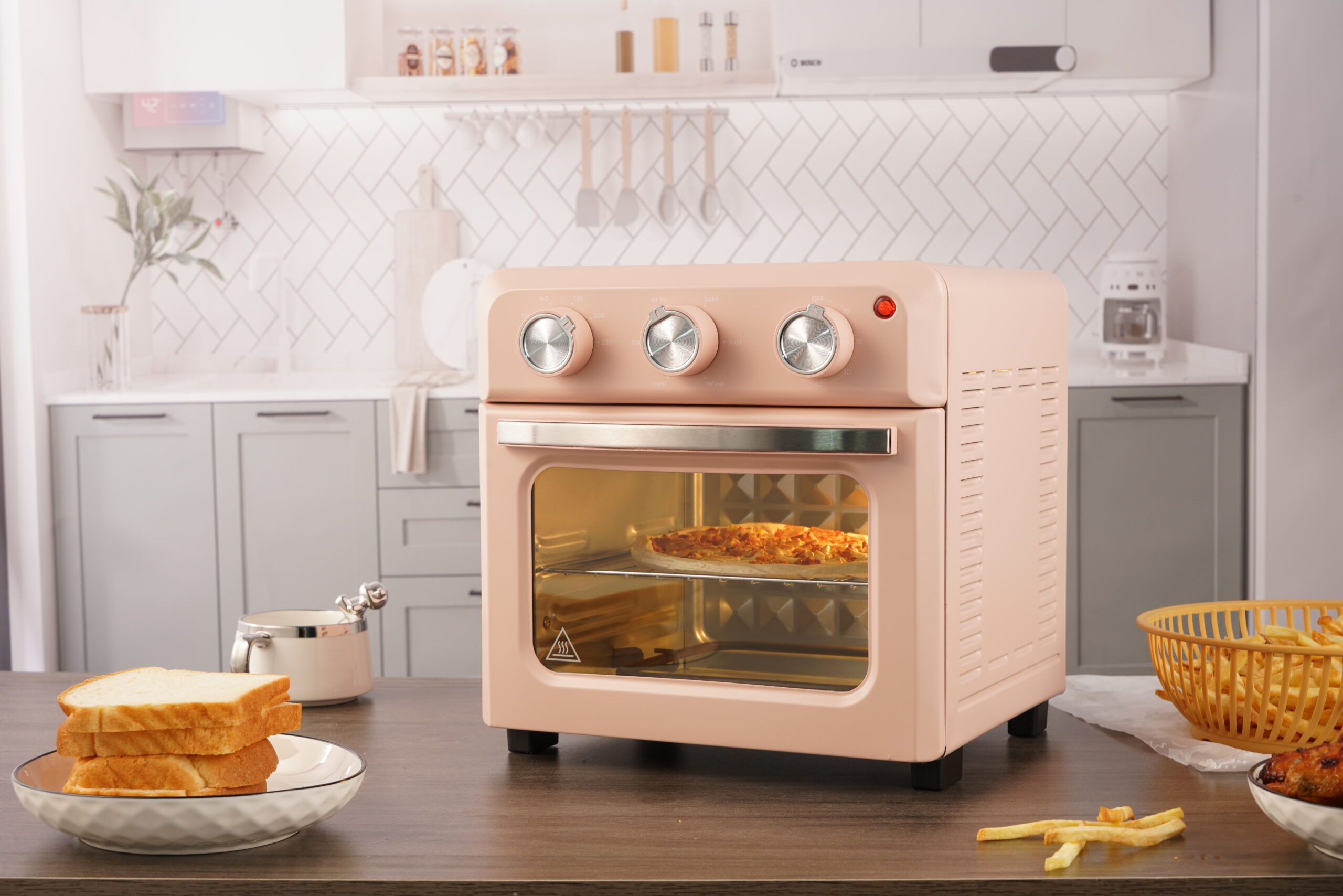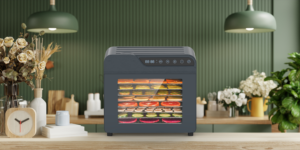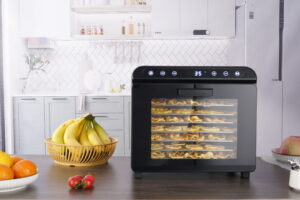As the Sales Manager at Foshan Linden Intelligent Appliances Co., Ltd., I’m passionate about helping home cooks achieve perfectly cooked meals with ease. From our factory in China, we produce top-quality 12L, 16L, and 30L air fryer ovens, air fryers, and food dehydrators, exported to North America, Europe, Russia, and the Middle East. A question I often hear at trade shows and through our website, lindensmart.com, is: Which appliance offers better heat distribution—an air fryer oven or a convection oven? I’m excited to share my expertise and compare these two cooking methods to help you choose the best for your kitchen.
In this article, I’ll dive into air fryer ovens and convection ovens, focusing on their heat distribution, cooking performance, and suitability for consistent results. Drawing from our experience at Linden, where we design innovative appliances with customizable settings, I’ll break down the pros and cons to guide your decision. Let’s explore which oven delivers the best heat distribution for your meals!
Understanding Air Fryer Ovens and Convection Ovens
Both air fryer ovens and convection ovens use fan-driven technology to circulate hot air, but their designs and purposes differ. Understanding these differences is key to evaluating their heat distribution.
What Is an Air Fryer Oven?
Air fryer ovens are compact, multi-functional appliances. They use rapid air circulation to cook food, delivering crispy textures with minimal oil. At Linden, our air fryer ovens combine frying, baking, roasting, grilling, and dehydrating, making them versatile for small to medium-sized meals.
What Is a Convection Oven?
Convection ovens are larger appliances, often built-in or countertop, that use a fan and exhaust system to circulate hot air. They’re designed for even cooking across large trays or multiple racks, ideal for baking, roasting, and broiling. They’re a staple in many kitchens but differ from air fryer ovens in size and scope.
Why Compare Heat Distribution?
I’ve seen buyers prioritize appliances that ensure consistent cooking results. Even heat distribution prevents undercooked or overcooked spots, delivering perfectly baked or fried foods. Comparing air fryer ovens and convection ovens helps you choose the best for uniform cooking.
How Air Fryer Ovens Work
Our air fryer ovens use high-speed air circulation to distribute heat. A powerful fan and heating element create a hot air vortex, cooking food evenly and quickly. According to Consumer Reports, air fryer ovens excel at delivering crispy results due to their concentrated airflow. Our 16L model, for instance, can roast vegetables or fry chicken wings with uniform crispiness.
Key Features for Heat Distribution
- Rapid Air Technology: Ensures even heat across small batches.
- Compact Chamber: Focuses heat for consistent results.
- Adjustable Settings: Precise temperature and time controls.
- Non-Stick Baskets: Promote even heat contact with food.
How Convection Ovens Work
Convection ovens use a fan and exhaust system to circulate hot air throughout a larger cooking chamber. This reduces hot spots and ensures even cooking across multiple racks or large trays. They’re ideal for baking cakes or roasting large cuts of meat, but their larger size affects heat concentration compared to air fryer ovens, per CNET.
Key Features for Heat Distribution
- Fan-Driven Airflow: Distributes heat across large surfaces.
- Spacious Chamber: Accommodates multiple trays or racks.
- Consistent Temperatures: Maintains steady heat for even cooking.
- Versatile Modes: Supports baking, roasting, and broiling.
Comparing Heat Distribution
Heat distribution is critical for consistent cooking results. Let’s compare how air fryer ovens and convection ovens perform in this area.
Air Fryer Ovens: Concentrated, Even Heat
Our air fryer ovens excel at heat distribution in smaller spaces. The compact chamber and high-speed fan create a concentrated airflow, ensuring every piece of food cooks evenly. For example, our 12L model can air fry a batch of fries with uniform crispiness in 15 minutes, avoiding undercooked centers or burnt edges.
Small-Batch Cooking
For small to medium batches, like a tray of chicken wings or vegetables, our air fryer ovens deliver superior heat distribution. The rapid air circulation wraps around food, cooking all sides evenly, as noted by Healthline.
Precision for Delicate Foods
The precise temperature controls in our air fryer ovens ensure even heat for delicate items like fish or cookies. This prevents overcooking, making them ideal for quick, consistent results.
Convection Ovens: Broad, Uniform Heat
Convection ovens are designed for larger-scale cooking. Their fan and exhaust system distribute heat across multiple racks or large trays, ensuring even baking or roasting. They’re excellent for big meals, like a whole turkey or multiple cookie sheets, per Good Housekeeping.
Large-Batch Cooking
For family-sized meals or baking multiple trays, convection ovens provide consistent heat distribution. The larger chamber and steady airflow ensure uniform results, even across crowded racks.
Baking and Roasting
Convection ovens shine for baking cakes or roasting large cuts of meat. The even heat prevents hot spots, ensuring a moist interior and evenly browned exterior.
Other Factors Impacting Heat Distribution
Beyond core technology, other factors influence heat distribution and overall performance.
Cooking Speed
Air Fryer Ovens: Faster Cooking
Our air fryer ovens cook up to 30% faster than conventional ovens, per Consumer Reports. The concentrated airflow in our 16L model, for example, roasts vegetables in 10–15 minutes, ensuring even heat with minimal time.
Convection Ovens: Slower but Steady
Convection ovens take longer, often requiring preheating (5–10 minutes) and extended cooking times for larger dishes. However, their even heat distribution ensures consistent results for big batches.
Versatility
Air Fryer Ovens: Multi-Functional
Our air fryer ovens handle frying, baking, roasting, grilling, and dehydrating. The compact design and rapid airflow make them versatile for small, evenly cooked meals, ideal for busy households.
Convection Ovens: Broad but Specialized
Convection ovens excel at baking, roasting, and broiling, especially for large quantities. They’re less suited for quick frying or dehydrating, limiting their versatility compared to air fryer ovens.
Ease of Use
Air Fryer Ovens: User-Friendly
Our air fryer ovens feature digital controls and preset modes, ensuring precise heat distribution with minimal effort. This makes them perfect for beginners or busy cooks who want consistent results.
Convection Ovens: More Complex
Convection ovens often require manual adjustments for temperature and fan settings. While effective, they may need more monitoring to achieve optimal heat distribution, especially for large meals.
Cleanup and Maintenance
Air Fryer Ovens: Easy Cleanup
Our air fryer ovens have non-stick, dishwasher-safe baskets, simplifying cleanup. The compact design reduces mess, ensuring even heat distribution doesn’t come with extra hassle, per Consumer Reports.
Convection Ovens: More Effort
Convection ovens have larger interiors and racks, making cleanup more time-consuming. Grease splatters or baked-on residue can require scrubbing, impacting convenience.
Energy Efficiency
Air Fryer Ovens: Low Energy Use
Our air fryer ovens use 1–1.5 kWh per use, per Energy Star. Their fast cooking times and compact size make them energy-efficient, maintaining even heat with minimal power.
Convection Ovens: Higher Energy Draw
Convection ovens use 2–5 kWh, especially with preheating and longer cooking times. While their heat distribution is excellent, they consume more energy for large-scale cooking.
Practical Applications for Heat Distribution
Both appliances offer strong heat distribution, but their applications vary based on your cooking needs.
Air Fryer Ovens: Perfect for Small, Quick Meals
Our 16L air fryer oven is ideal for small to medium meals, like crispy fries or roasted chicken breasts. The concentrated airflow ensures even cooking, making it perfect for weeknight dinners or snacks.
Convection Ovens: Great for Large, Complex Dishes
Convection ovens shine for family-sized meals or baking multiple trays. Their broad heat distribution ensures even results for roasts, casseroles, or batches of cookies, ideal for gatherings.
Health Benefits and Heat Distribution
Even heat distribution impacts health by preserving nutrients and reducing oil use.
Air Fryer Ovens: Healthier Cooking
Our air fryer ovens use minimal oil, reducing fat by 70–80%, per Harvard Health. The even heat distribution cooks food quickly, preserving nutrients like vitamin C in vegetables.
Convection Ovens: Nutrient Retention
Convection ovens maintain steady heat, preserving nutrients in large dishes like roasted vegetables or meats. However, longer cooking times may degrade some heat-sensitive vitamins compared to air fryer ovens.
Quality and Reliability
At Linden, quality is our priority. Our air fryer ovens undergo rigorous testing, meeting UL and CE standards for safety and durability. The robust design ensures consistent heat distribution, delivering reliable results for every meal.
Logistics and Customer Support
From my experience with global buyers, logistics are crucial. Our air fryer ovens are lightweight and easy to ship, ensuring timely delivery worldwide. We streamline production to meet tight schedules. Need assistance? I’m here at sales4@fslinden.com for expert guidance.
SEO-Friendly Tips for Choosing an Oven
To pick the best oven for heat distribution, here are tips optimized for search terms like “air fryer oven vs convection oven” or “best heat distribution ovens”:
- Assess Batch Size: Choose air fryer ovens for small meals, convection ovens for large ones.
- Prioritize Speed: Opt for air fryer ovens for faster cooking.
- Check Controls: Look for precise settings for consistent heat.
- Read Reviews: Explore platforms like CNET for insights.
- Test at Trade Shows: Try appliances hands-on to evaluate performance.
Final Thoughts: Which Offers Better Heat Distribution?
As someone who loves helping cooks achieve perfect results, I believe our air fryer ovens offer the best heat distribution for most home kitchens. Their compact design and rapid air technology deliver even, crispy results for small to medium meals, making them ideal for daily use. Convection ovens excel at distributing heat across large batches, but their size and energy use may not suit every household. Your choice depends on your cooking needs, kitchen space, and meal sizes.
Ready to cook with perfect heat distribution? Visit lindensmart.com to explore our air fryer ovens, or email me at sales4@fslinden.com for personalized advice. Let’s make your meals consistently delicious!
Meta Title: Air Fryer Oven vs Convection Oven: Best Heat Distribution
Meta Description: Compare air fryer ovens and convection ovens for heat distribution. Discover which delivers even cooking for your meals.




